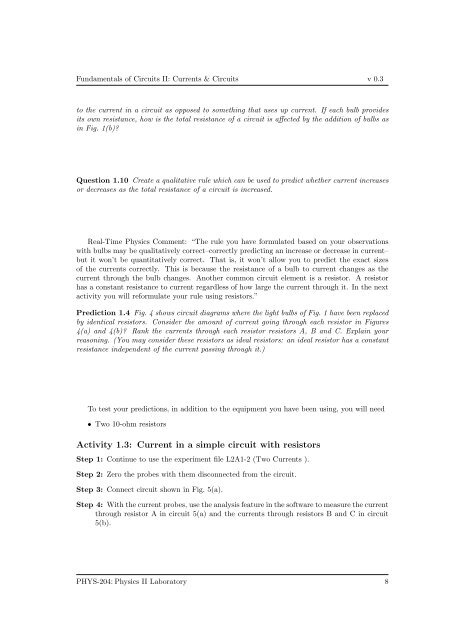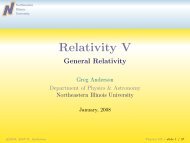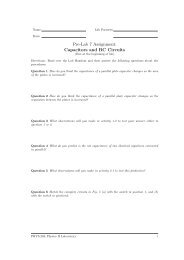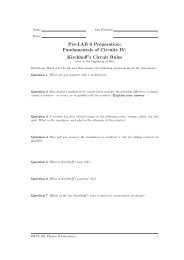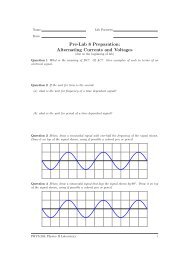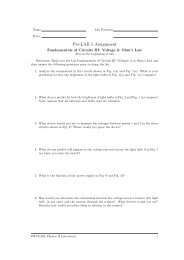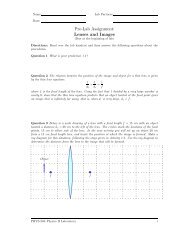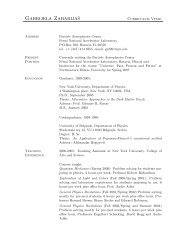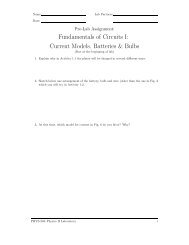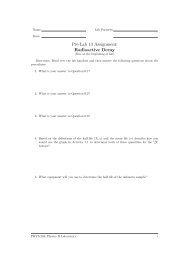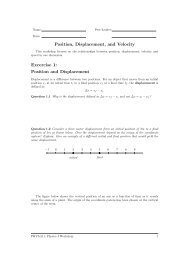Pre-LAB 4 Assignment Fundamentals of Circuits II: Currents ...
Pre-LAB 4 Assignment Fundamentals of Circuits II: Currents ...
Pre-LAB 4 Assignment Fundamentals of Circuits II: Currents ...
Create successful ePaper yourself
Turn your PDF publications into a flip-book with our unique Google optimized e-Paper software.
<strong>Fundamentals</strong> <strong>of</strong> <strong>Circuits</strong> <strong>II</strong>: <strong>Currents</strong> & <strong>Circuits</strong> v 0.3<br />
to the current in a circuit as opposed to something that uses up current. If each bulb provides<br />
its own resistance, how is the total resistance <strong>of</strong> a circuit is affected by the addition <strong>of</strong> bulbs as<br />
in Fig. 1(b)?<br />
Question 1.10 Create a qualitative rule which can be used to predict whether current increases<br />
or decreases as the total resistance <strong>of</strong> a circuit is increased.<br />
Real-Time Physics Comment: “The rule you have formulated based on your observations<br />
with bulbs may be qualitatively correct–correctly predicting an increase or decrease in current–<br />
but it won’t be quantitatively correct. That is, it won’t allow you to predict the exact sizes<br />
<strong>of</strong> the currents correctly. This is because the resistance <strong>of</strong> a bulb to current changes as the<br />
current through the bulb changes. Another common circuit element is a resistor. A resistor<br />
has a constant resistance to current regardless <strong>of</strong> how large the current through it. In the next<br />
activity you will reformulate your rule using resistors.”<br />
<strong>Pre</strong>diction 1.4 Fig. 4 shows circuit diagrams where the light bulbs <strong>of</strong> Fig. 1 have been replaced<br />
by identical resistors. Consider the amount <strong>of</strong> current going through each resistor in Figures<br />
4(a) and 4(b)? Rank the currents through each resistor resistors A, B and C. Explain your<br />
reasoning. (You may consider these resistors as ideal resistors: an ideal resistor has a constant<br />
resistance independent <strong>of</strong> the current passing through it.)<br />
To test your predictions, in addition to the equipment you have been using, you will need<br />
• Two 10-ohm resistors<br />
Activity 1.3: Current in a simple circuit with resistors<br />
Step 1: Continue to use the experiment file L2A1-2 (Two <strong>Currents</strong> ).<br />
Step 2: Zero the probes with them disconnected from the circuit.<br />
Step 3: Connect circuit shown in Fig. 5(a).<br />
Step 4: Withthecurrentprobes, usetheanalysisfeatureinthes<strong>of</strong>twaretomeasurethecurrent<br />
through resistor A in circuit 5(a) and the currents through resistors B and C in circuit<br />
5(b).<br />
PHYS-204:Physics <strong>II</strong> Laboratory 8


